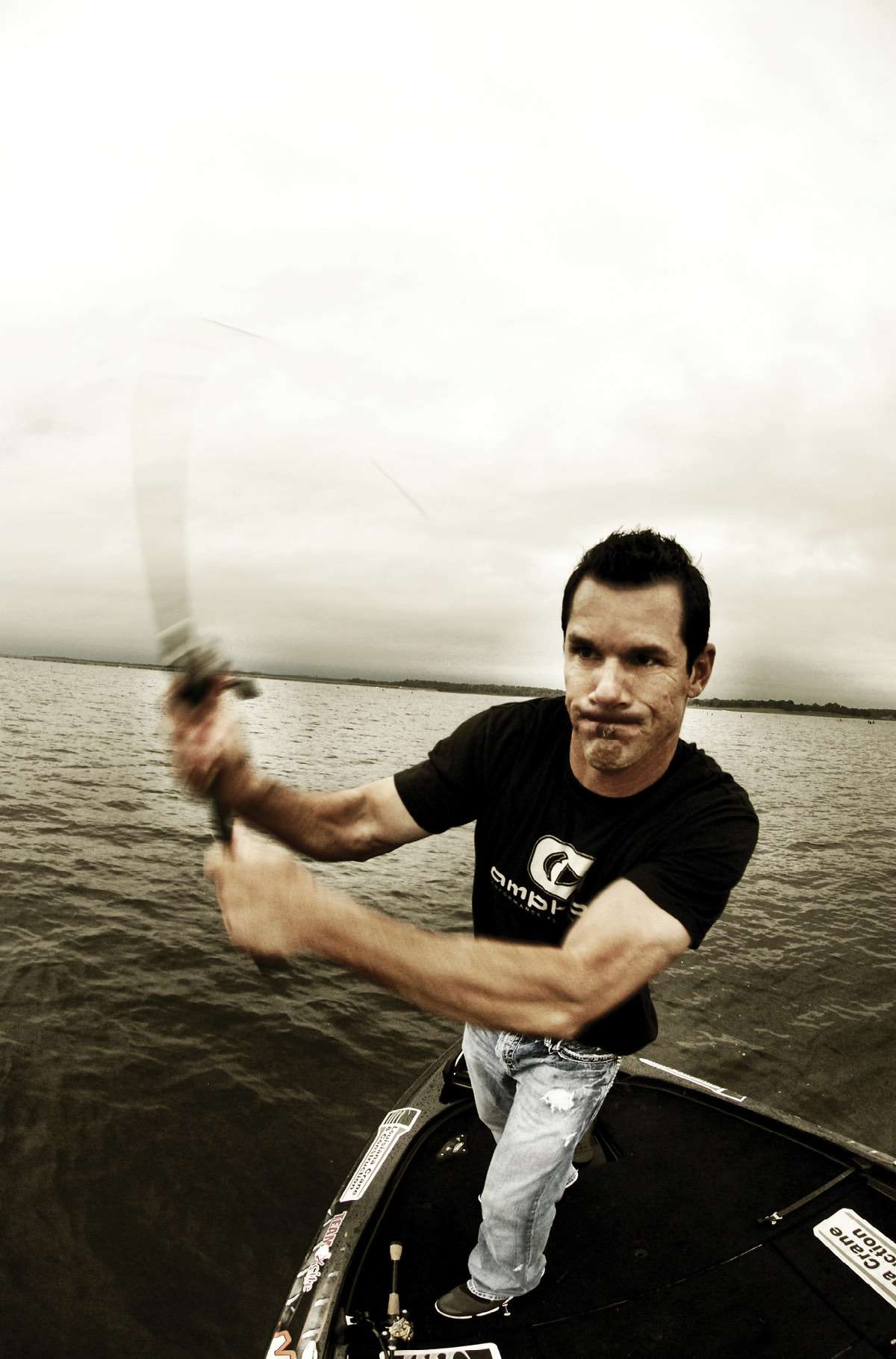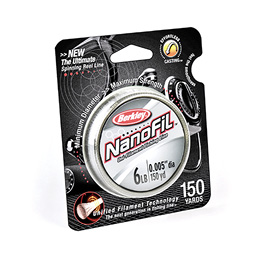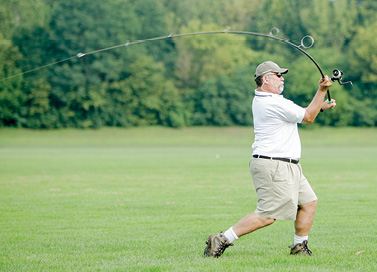
Yearning for the 100-yard cast?
Yeah, me, too. But I’m not holding my breath.
There are times, though, when if you could only reach out a few more yards …
According to a lot of great anglers, extending your range 10 to 15 yards is very doable for most of us. Casts out to 50, 55 or even 60 yards are in the ballpark if we gear up and get the mechanics of the cast just right, these pros tell us.
Your actual average casting distance may surprise you; most of us overestimate our range. Walk out in the backyard right now with your favorite rig and lure — odds are you’ll find that 45 measured yards is a long cast for you. So if you’re an “average” caster, you can add as much as 15 yards to your casts with the right gear and the right tactics.
Is it worth going after that extra distance?
Sometimes, you bet it is.
“When you’re throwing a big topwater on the points in clear, calm water during the blueback herring bite, getting that lure way out away from the boat can be the whole story,” says Elite Series pro Casey Ashley of South Carolina.
“With deep crankbaits, if you’re not getting them way out there, you’re not getting them down to where the fish are on the retrieve,” says Elite Series pro Grant Goldbeck. “The farther you can throw, the deeper you can fish them.”
“Prespawn and postspawn, when the fish are still on shallow flats leading to or from the spawning areas, making long throws can really help you connect without spooking them,” says Elite Series pro Stephen Browning of Arkansas.
But what are the secrets? When do you need to go long, and how is it that some guys can consistently reach way out there and touch distant fish? Here are a few tips.
CRANKBAITING: 8-0 parabolic, 10-lb. Fluoro
The long cast in crankbaiting is all about getting the lure to its maximum depth and keeping it there — the farther you can put it from the boat, the deeper it will run.
And, since you don’t have to “work” a crankbait much with the rod, you can take advantage of extra length in your sticks to really reach out there.
“Adding length and power to a rod is like adding draw-weight to a bow,” says Paul Davis, associate brand manager for Abu Garcia. “You get more lure speed and potentially more distance.”
The ultimate crankbait stick these days, most pros agree, is between 7-5 and 8-0, medium-heavy action with a medium tip — a combo that creates a more-or-less “soft” or parabolic action that works well both for distance and for providing a bit of “give” when a lunker tries to shake the hooks. Most crankbaiters fish fluorocarbon line because it sinks, making it easier to keep a lure deep than with mono or braid. And the thinner the line, the better, both for distance in the cast and for reduced water resistance, allowing a deeper dive.
TOPWATER: 6-6 parabolic, 50-lb. Braid
At blueback time, postspawn and again in early fall, he who casts longest catches most. Get too close, and the bait dives, taking the bass with it. Ashley, noted for his success on this pattern, has this advice.
“You want a long cast, but you can’t use a really long rod because you’ve got to work the lure with it, and the longer the rod, the harder it is to work a topwater. So I usually go with a 6-6 Quantum rod, and I put 50-pound-test Stren Sonic braid on the Exo reel. That gives me good distance with a big [Lucky Craft] Sammy or Gunfish 115, and I can still work the rod all day without wearing out my wrists.”
The braid, says Ashley, gives better lure action and far better hook sets because there’s no stretch. The fact that it floats is a plus, he says, for this application. He doesn’t go lighter than 50 because thinner braid tends to dig into the line layers under it and causes backlash problems.
Long casts also come in handy anytime schoolers pop up on top. The farther back you can keep the boat, the more of these guys you can catch before they go down.
SPYBAITING: 7-0 medium, 6-lb. Fluoro
Goldbeck says spybaiting is becoming his go-to tactic when the bite is tough, and success usually requires long casts with light spinning tackle.
“I find the fish on sonar, back way off and make the longest cast I can, then count the bait down to where the fish are and make a very slow retrieve,” the Texas pro says. “I’m using a Duo Realis Spinbait 80 and reeling it just fast enough to make the props turn and the body wobble.”
Goldbeck uses a Shimano SA2500FG reel loaded with Sunline 6-pound-test fluorocarbon on a 7-foot Dobyns rod for this duty.
“Fill the spool completely, stick with the thinnest lines and remember that tip speed is [the] key to distance,” Goldbeck advises.
JUMBO SWIMBAITS AND UMBRELLA RIGS: 7-9 Heavy, 80-lb. Braid
Large swimbaits fished in clear water lakes, such as those in Southern California, account for some huge bass, but again, it often takes a long throw to fool the fish — and we’re talking lures here that may weigh up to a half-pound! Umbrella rigs, though not legal in major tournaments, are a productive way to put big fish in the boat when nothing else works, and they also require big casts and powerful tackle to achieve the necessary distance for retrieves down where the lunkers live.
Abu Garcia’s Veritas rod, which measures 7 feet, 9 inches, is specifically designed for this duty, notes Davis. “It’s got a lot of power, a slower tip so that it really loads up with these heavy baits and rigs, and an extended, 17 1/2-inch handle to increase leverage and casting distance.”
This year’s ICAST Best of Show baitcasting rod, the G.Loomis NRX Umbrella Rig rod, was also aimed at umbrella rigs and other mega-lures. It’s a 7-foot, 7-inch rod with an extended full cork grip.
“The combination of exceptionally light weight, a soft tip and a power grip makes this a great rod for throwing heavy baits,” says company spokesman Bruce Holt, “and it’s got the strength to handle braid up to 80-pound test.”
Shimano’s Crucial Umbrella Rig rod is a 7-9 that adds an extra 1 1/2 inches to the handle compared with other rods of this length, with heavy action and a fast tip. The company says the heavy lower sections make long casts easy with the ungainly rigs, while the fast tip makes strong, repeated hook sets easy.
Wright & McGill’s Skeet Micro Honeycomb umbrella stick is 7-5, and 20 inches of that is the man-size handle — leverage is king when handling the rigs. It’s a fast taper designed for 15- to 40-pound-test line.
FOR SPINNING REELS ONLY
 Berkley’s Nanofil line, a braid that’s slicker and far thinner than monofilament, has been widely recognized for its amazing ability to add casting distance to spinning rigs. A 10 percent increase is common over conventional mono or fluoro. The line has a “springy” quality that causes it to leap off the spool on the cast, reducing drag to near zero, plus the amazing slipperiness allows it to glide through the guides without slowing even the lightest of lures. The line is pricey, and too thin for use on baitcasters, but for spinning applications where maximum distance is key, it’s hard to beat.
Berkley’s Nanofil line, a braid that’s slicker and far thinner than monofilament, has been widely recognized for its amazing ability to add casting distance to spinning rigs. A 10 percent increase is common over conventional mono or fluoro. The line has a “springy” quality that causes it to leap off the spool on the cast, reducing drag to near zero, plus the amazing slipperiness allows it to glide through the guides without slowing even the lightest of lures. The line is pricey, and too thin for use on baitcasters, but for spinning applications where maximum distance is key, it’s hard to beat.
TIPS FROM A WORLD-CHAMPION CASTER
 Steve Rajeff, director of engineering for G.Loomis Rods, who has won the American Casting Association All-Around Distance Competition 38 consecutive times and the world championship 13 times, once made a throw of 518 feet using a 6-foot baitcasting rig firing a 5/8-ounce weight! Though distance casting gear varies significantly from bassing gear, Rajeff offers these tips that should be of use to all of us.
Steve Rajeff, director of engineering for G.Loomis Rods, who has won the American Casting Association All-Around Distance Competition 38 consecutive times and the world championship 13 times, once made a throw of 518 feet using a 6-foot baitcasting rig firing a 5/8-ounce weight! Though distance casting gear varies significantly from bassing gear, Rajeff offers these tips that should be of use to all of us.
Longer rods equal longer casts.“I use a 13-footer in some of my competitions — obviously too long for a bass boat, but in general, the longer rod you can handle, the easier it will be to get more distance.”
Thin lines cast farther.“The diameter definitely makes a difference,” Rajeff says. “If you’re crankbaiting or throwing an umbrella rig, you might want heavier line to avoid losing lures, but thinner line does cast farther.”
Lure shape has an impact.“Some swimbaits and crankbaits are as aerodynamic as a tennis shoe. Choose lures weighted toward the tail and as streamlined as possible for long-cast situations.”
Keep reels clean but not over-oiled. “You obviously don’t want any dirt in your reel, but be sparing with a very thin grade of oil on any parts involved in the cast; oil can be ‘sticky’ and slow a cast otherwise.”
Tune your reel.“Use less centrifugal or magnetic braking rather than more. Back off on four of the six centrifugal brakes, and you’ll be about right for most lure weights and setups, but tune it to what you’re trying to accomplish.”
Step into it.“For a right-handed caster, your left foot is forward, and as you power the rod past your shoulder, you step forward with your right, pivoting your body. Just a short step can really add to the distance.”
Do try this at home.“Go out in the backyard and try different lures, lines and reel settings. You’ll get a lot better feel for what works for you than on the water.”
BODY LANGUAGE
While most of us cast with our arms and wrists, when you really want to reach out there, putting your trunk and legs into it can make a big difference.
Elite Series pro Kevin Hawk of Alabama puts his body into his longest casts. “If I need an extra-long cast, I swing the rod from the side and pivot as it drives forward to gain tip speed,” says Hawk, who uses a 7-5 iRod Air as his “big gun,” with an Abu Garcia Revo SX reel and Seaguar Kanzen braid. “I back off completely on the cast-control knob and control spool speed with the edge of my thumb.”
THE REEL THING
Most modern reels, properly adjusted, will put a lure into orbit. But some seem to have a few design advantages.
“I really like the new Lew’s BB1 Pro Series,” Browning says. “It’s got an oversize titanium line guide that has been moved forward so the distance from the spool to the guide is increased. This lowers friction and really seems to help my distance.”
Many anglers also like the Tatula series from Daiwa, which has a T-Wing line guide, open at the top so the line doesn’t have to “push” the levelwind as it flies off the spool.
SELECTING A ROD
- A long handle on a rod improves your leverage during the swing, allowing for longer casts.
- For added distance, choose a parabolic action, where the rod bends farther down the blank.
- The overall length of your rod is important. The longer, the farther you will cast.
- Premium rod guides are an important consideration when choosing a rod for distance casting.
- Going long is all about tip speed. Make sure your rod has a fast tip to assist with the launch.
To view more of Bassmaster Magazine, click here.




